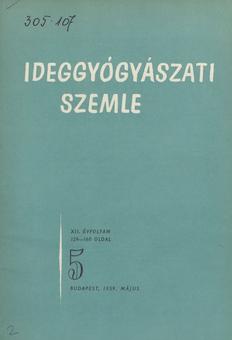The eLitMed.hu medical portal uses computer cookies for convenient operation. Detailed information can be found in the Cookie-policy.
Clinical Neuroscience - 1959;12(05)
Content
[About Lissauer's apperceptive blindness]
[A 59-year-old patient with Alzheimer's disease slowly developed object agnosia, prosopagnosia, spatial disorientation, and apraxia of dressing over five years. There is evidence of visual analyser disability, left hemianopsia, visual loss. In projection at distance and angle of tachystoscopic examination, paralysis of the Bálint gaze. In addition, progressive dementia. None of the usual symptoms of colour agnosia or colour naming disorder, and no aphasia in any other way. These are the symptoms analysed by the author, who does not yet see any justification for dropping the traditional concept of agnosia, which has been a matter of debate in the literature in recent years.]
[Central nervous system metastases from malignant melanoma ]
[The authors provide a clinicopathological description of five CNS m. m. metastases and, in their assessment, conclude : 1. CNS metastases of m. m. occur in 8-12% of other malignant tumour metastases. 2. They draw attention to the danger of removing naevi and melanomas. 3. The most common clinical presentation is subarachnoid haemorrhage. Symptoms of multiple metastasis are often difficult to recognise. 4. The need for neurosurgical intervention is emphasized in the presence of symptoms suggestive of a nodule. The tissue picture suggests a neuroectodermal origin of melanoma. They seek to explain the pathomechanism of the frequent subarachnoid haemorrhage and address the mode of metastasis.]
[Structural analysis of Wahnstimmung]
[In our cases, we provided a psychopathological analysis of Wahnstimmung in the light of a structural approach. The regression symptoms of the relational structure are prominent in the state picture. The emotional polarization disorder due to the lack of differential inhibition results in total perplexity, anticipatory uncertainty, ambivalence that generally colours psychic events. The symptoms are accompanied by phenomena triggered by a reduction in psychic energy and regression of cognitive and adaptive structures. In cases where the structural regression symptoms are accompanied by an energetic insufficiency, the condition is stuck in a state of pathological imbalance constituting the delirium. The striving for a new pathological state of equilibrium manifests itself in the personality's effort to correct itself in the face of pathological symptoms. In such cases, new dynamic stereotypes are seen to develop in the form of secondary pathological cognitive structures, in the form of positive or negative misconceptions. ]
[Effect of vasomotor reflexes on abnormal electroencephalogram]
[A review of our data and a comparison with the literature shows that in our patient population, only a relatively small percentage of activation procedures described by others have been successful. The large number of patients included in our study precludes us from explaining negative cases by statistical variance. In particular, it is difficult to explain the ineffectiveness of apnce, because while in carotid compression it is conceivable that the pressure was not applied in the right place and with the right force, in the patient who underwent apnce we were able to check in all cases that the patient complied with our request. Based on the negative results, the activation methods listed were no longer used indiscriminately in all patients. Carotid artery compression and oculo-cardiac reflex are performed in patients where it is necessary to differentiate between syncope and sacer. In vascular pathologies, amyl nitrite inhalation will continue to be performed. This is a relatively difficult EEG diagnostic problem and the small number of positive cases justifies the use of this test. Evipan is routinely used in combination with hyperventilation. This has the distinct advantage, in our opinion, of achieving the same effect with a relatively low dose of Evipan, which is therefore harmless, as compared to deeper anaesthesia, which requires a higher dose, or other more prolonged methods that are more likely to have complications.]
[Formation of an ophthalmo-otoneurology working group]
[The author reports on the ophthalmo-otoneurological working group established on 25 March 1959 at the headquarters of the Medical-Health Trade Union, within the framework of the "Pavlov" Neurological Specialist Group.]
1.
Clinical Neuroscience
[Headache registry in Szeged: Experiences regarding to migraine patients]2.
Clinical Neuroscience
[The new target population of stroke awareness campaign: Kindergarten students ]3.
Clinical Neuroscience
Is there any difference in mortality rates of atrial fibrillation detected before or after ischemic stroke?4.
Clinical Neuroscience
Factors influencing the level of stigma in Parkinson’s disease in western Turkey5.
Clinical Neuroscience
[The effects of demographic and clinical factors on the severity of poststroke aphasia]1.
2.
3.
4.
5.



